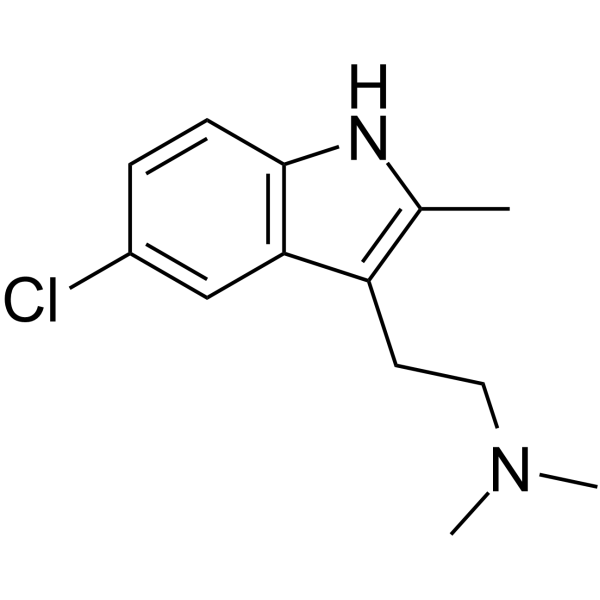ST1936

ST1936 structure
|
Common Name | ST1936 | ||
|---|---|---|---|---|
| CAS Number | 1210-81-7 | Molecular Weight | 236.740 | |
| Density | 1.2±0.1 g/cm3 | Boiling Point | 377.0±42.0 °C at 760 mmHg | |
| Molecular Formula | C13H17ClN2 | Melting Point | N/A | |
| MSDS | Chinese USA | Flash Point | 181.8±27.9 °C | |
| Symbol |

GHS07 |
Signal Word | Warning | |
Use of ST1936ST1936 is a selective, nanomolar affinity 5-HT6 receptor agonist with Ki values of 13 nM, 168 nM and 245 nM for human 5-HT6, 5-HT7 and 5-HT2B receptors, respectively. ST1936 also shows moderate affinity (Ki of 300 nM) for human and rat α2 adrenergic receptor[1]. |
| Name | ST-1936 |
|---|---|
| Synonym | More Synonyms |
| Description | ST1936 is a selective, nanomolar affinity 5-HT6 receptor agonist with Ki values of 13 nM, 168 nM and 245 nM for human 5-HT6, 5-HT7 and 5-HT2B receptors, respectively. ST1936 also shows moderate affinity (Ki of 300 nM) for human and rat α2 adrenergic receptor[1]. |
|---|---|
| Related Catalog | |
| Target |
5-HT6 Receptor:13 nM (Ki) 5-HT7 Receptor:168 nM (Ki) 5-HT2B Receptor:245 nM (Ki) α1-adrenergic receptor:390 nM (Ki, rat) α2-adrenergic receptor:300 nM (Ki, rat) α2-adrenergic receptor:300 nM (Ki, human) |
| In Vitro | ST1936 appears to be relatively selective for 5-HT6 receptors, although it has shown affinity also for 5-HT2B, 5-HT1A, 5-HT7 receptor and α-adrenergic receptors when tested in a broad crossreactivity panel that comprised G-protein-coupled receptors, ion channel binding sites, enzymes, and transporters[1]. ST1936 behaves as a full 5-HT6 agonist on cloned cells and is able to increase Ca2+ concentration, phosphorylation of Fyn kinase, and regulate the activation of ERK1/2 that is a downstream target of Fyn kinase[2]. ST1936 reduces the frequency of spontaneous excitatory postsynaptic currents, with an IC50 of 1.3 μM[3]. |
| In Vivo | ST1936 (5, 10, 20 mg/kg; i.p.) increases in a dose dependent manner extracellular dopamine (DA) and NA levels in the prefrontal cortex (PFCX)[4]. ST1936 (5, 10, 20 mg/kg; i.p.) increases extracellular DA and NA levels in the nucleus accumbens (NAc) core. Doses of 10 mg/kg increases dialysate DA (peak: 179%) while higher dose increases both DA and NA dialysates (201% and 231%, respectively). Doses of 5 mg/kg does not produce any effect[4]. |
| References |
| Density | 1.2±0.1 g/cm3 |
|---|---|
| Boiling Point | 377.0±42.0 °C at 760 mmHg |
| Molecular Formula | C13H17ClN2 |
| Molecular Weight | 236.740 |
| Flash Point | 181.8±27.9 °C |
| Exact Mass | 236.108032 |
| LogP | 3.31 |
| Vapour Pressure | 0.0±0.9 mmHg at 25°C |
| Index of Refraction | 1.614 |
| InChIKey | KSYMELKKLOFABL-UHFFFAOYSA-N |
| SMILES | Cc1[nH]c2ccc(Cl)cc2c1CCN(C)C |
| 2-(5-Chloro-2-methyl-1H-indol-3-yl)-N,N-dimethylethanamine |
| ST-1936 |
| 1H-Indole-3-ethanamine, 5-chloro-N,N,2-trimethyl- |